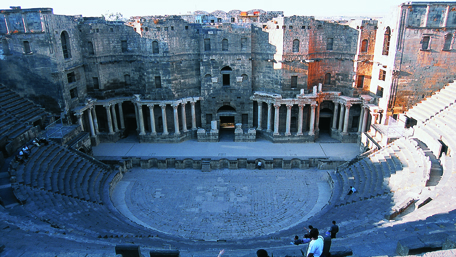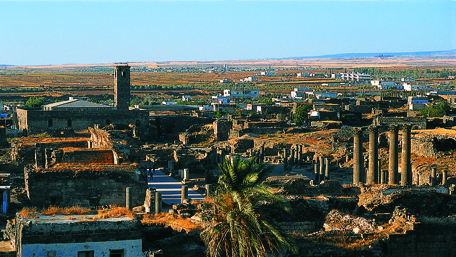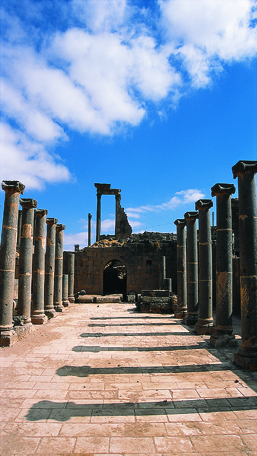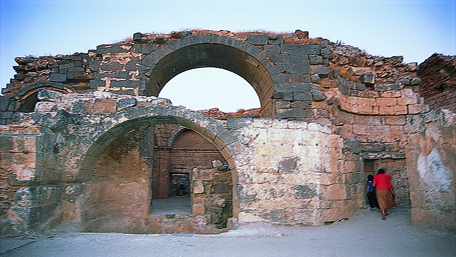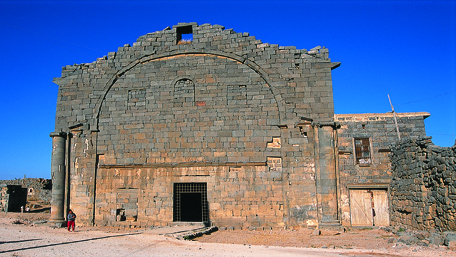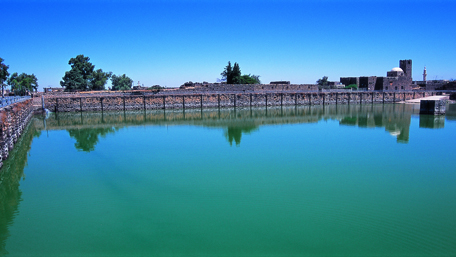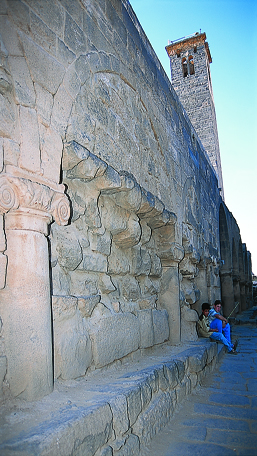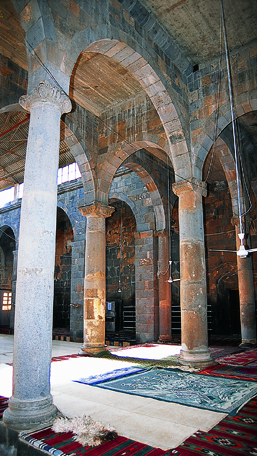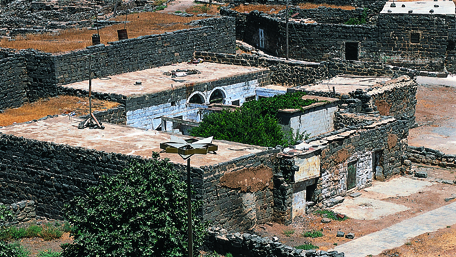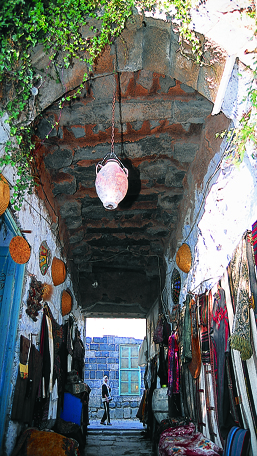Its basalt stones fit together in a vivid testimony of the history of several civilizations. Quoted on the tablets of Tell Amarna, correspondence between the pharaoh and the Phoenician kings. Second capital of the Nabateans after Petra, seat of the Roman governor of the time of Trajan, deeply Arab… Only city governed by a Christian patriarch, flagship city of Islam, Bosra,”the citadel”, a name that suits it, because it is only now that it is willing to reveal its wealth. And the sand of centuries gradually slides of this secret, mystical city, long forgotten.
The best preserved Roman amphitheater in the world, 140 km from Damascus and 850 meters above sea level on the plateau of the Hauran.
© Prestige / Bassam Lahoud
The amphitheater dates from the golden age of the city in the time of the Emperor Trajan, Bosra was then called Nova Trajana. This second-century amphitheater with perfect acoustics is the best preserved of the Roman world. Arranged over arcades, technical architecture that allowed the construction of elevations on a flat surface, the auditorium could host 15.000 spectators in1st, 2nd and 3rd classes, according to social status.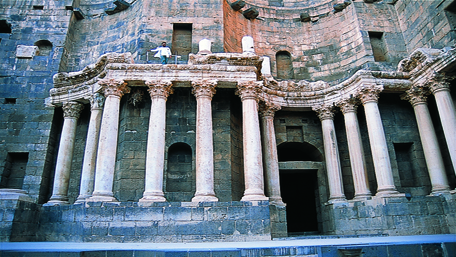
© Prestige / Bassam Lahoud
The stage is 45 meters long, the marble façade facing was embellished with statues in niches lit at night. A gallery hosted the wings of acting scenes. At the bottom of the stage, a small chamber was reserved for the orchestra or the athletes.The safety deployment of this magnificent amphitheater should inspire our contemporary architects: the installation of several exits allowed to evacuate the place, despite its considerable size and the number of seats and bleachers, in just fifteen minutes. The area was covered with printed silk hangings that protected from the sun in summer and rain in winter. The highest point of sophistication: they used to boil scented water, vapors fell into fine droplets on the delighted crowd. The Nabataeans also honored the semicircular Chamber. Every four years, they were celebrating their festivals and presented offerings to the god Dusares. And if this amphitheater has been well preserved, it is thanks to the fortifications around it, whose main contractor is none other than Saladdin, but also the sands of time that covered the bleachers…What is surprising in Bosra is that the historic city becomes part of the daily life of the city, cozy and far from being stuck in the past. Children approach you with a smile, speak to you in several languages: snippets of explanations they have picked up here and there by following the guides …
The whole city of Bosra is constructed with basalt, a volcanic rock highly resistant
© Prestige / Bassam Lahoud
A view of the city where several civilizations overlap and coexist: Nabataean, Roman, Byzantine, Islamic… At the left one can see the minaret with a square base of the Al Omari mosque, the market for molasses: Khan el Debs, Roman fitted columns… Made up when it was founded after the Roman urban plan, the city is organized around the spa, water lilies and utilities.This citadel of 17,000 square meters, the Crusaders dreamed to seize it and to this end, raised their armies, but despite their repeated attacks, they could not cross its walls. This citadel was at that time protected by a moat that prevented the passage of horses to enter the fortress, a portal located right way and not in the center. The enemy soldiers trying to break down the door with a “ram” had not been able to succeed because of lack of space and outburst…Ayyubid archers posted themselves to deadly, ready to shoot their arrows at the attackers.
The Nabataean people installed in Jordan enjoyed great political, military and economic influence. From the first century BC, the Nabateans extended their power to the south of Syria and pushed on to Damascus. It is especially at the time of Aretas III that Bosra became more important and became the second Nabatean capital with Petra. The South remained under Nabataean domination even after the Roman conquest, until the arrival of Trajan to the early second century. The Nabataean art is distinguished by its simplicity: flat, smooth stones, rare motifs, columns engaged in the front and capitals with horns that stand out from the highly decorated Greco-Roman columns. Getting to Bosra, is to know a city off the usual tourist track and has paid tribute to history. On the set of Hauran, 140km south of Damascus, reconnect with the crossroads of caravans, a city that shakes with its basalt our memories.
The sanctuary Kalybé evokes the legendary tragedy of a princess who could not escape the fate.
© Prestige / Bassam Lahoud
The remains of Kalybé and in front of the market, Khan el Debs, in the early XXth century, people still sold molasses. Khan is at the heart of the city, this is the place where people came to trade in goods, fabrics, carpets. In the evening, all were stored in niches and doors were closed overnight.The tradition of Kalybé at the heart of Bosra, tells that a king has built this “palace” to house his beloved daughter and protect her from harm. They brought her food through a basket. One day they sent her a bunch of grapes; there was a scorpion slipped and pierced the beautiful girl who succumbed. This concept of fate and inevitable death is found in the Syrian-Greek ancient culture.
The Cathedral of Bosra inspired the Aya Sofia basilica, Romanesque churches in the West and Islamic art
The Cathedral of Bosra, almost forgotten by the rest of the world was of crucial importance on the architecture of places of worship: when Emperor Justinian built the Hagia Sophia in Constantinople, he demanded of architects to take as a model the Cathedral of Bosra, which also had tremendous influence on Islamic art. It was built in 512 in the glory of the Saints Sergius, Bacchus, Leontos, the most important and popular after St. George. Syrian martyrs, all three lived in Roman times. Denying the worship of the god Jupiter, they were tortured and put to death without mercy, under Maximian in the late third century. The cathedral is the oldest example of domed church with a square plan. The apse always oriented towards the East, the faithful and the priest to face the sun, the “right way.”To the right of the apse, the martyrium that hosts the relics. The church was organized around an octagonal centre lined by columns that supported the dome. Romanesque architecture that developed in Europe to the IXth and Xth centuries owes much to Oriental Christian art. Architects on a pilgrimage to the holy places and passage in Bosra were so fascinated by the cathedral they have reproduced some elements in their churches in Europe. The Cathedral of Bosra has inspired several churches of its time, the VIth century, with its dome inscribed in a square.
© Prestige / Bassam Lahoud
The Roman Baths. At the entrance, a pool was used for feet toilet. The baths usually consist of frigidarium, tepidarium and caldarium. Or at Bosra, two caldariums had been built, people came for massage. Niches hidden by curtains acted as locker rooms. Today, the dome is being restored.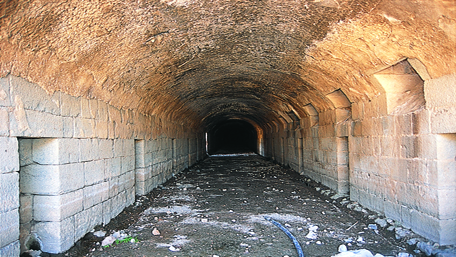
© Prestige / Bassam Lahoud
The Roman cryptoporticus was used as an underground warehouse, and communicated with the market. It runs along the decomanus over 100 meters.34 openings shaped skylight assured ventilation and lighting in the warehouse.Place full of mysticism, the Prophet Muhammad will make a decisive encounter: the wise monk Buheira
There, the monk Buheira received the Prophet Muhammad and predicted his vocation. The young Muhammad accompanied his uncle on his frequent trips. The caravans were used to stop at Bosra, crossroads and major water source. The Prophet had many opportunities to meet Buheira. It is therefore in the XIth century that Christianity welcomed Islam, a must place in history and religion. Ancient roman temple, it was converted into a church in the IVth century. A unique nave, a semicircular apse facing East where the sun rises, as required by the Christian tradition, that a curtain hided to the faithful. To access the inner sanctum, you had to climb a few stairs. Buheira, a visionary monk, was the spiritual leader of the Nestorian movement who saw Christ in his human nature and maintained that Mary was the mother of Christ the man.
© Prestige / Bassam Lahoud
The Church of the monk Buheira in Bosra.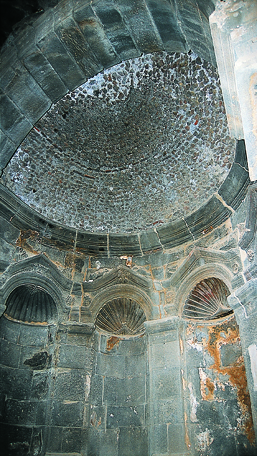
© Prestige / Bassam Lahoud
Remains of a pagan temple, attached to the church of the monk Buheira. Note the small stone arch and delicately carved relief in basalt stone yet difficult to carve.Crossroads of caravans, stopover for pilgrims the large pool of Bosra dating back to the IIIrd century…
© Prestige / Bassam Lahoud
The large pool of Bosra, built during the reign of Trajan in the IId century AD on the heights of the city to irrigate the fields, had an area which at the time stood eight feet deep! After the Islamic conquest, Bosra became a stopover for large caravans of pilgrims, the pool is now called Birkat al Hajj. Today, this majestic “artificial lake”supplies Bosra with water which has its source in Jabal al Arab on an altitude of thousand meters .It is also a promenade very popular to the inhabitants of Bosra. Off to the right, we can see the mosque-school “madrassa” Abul Fida, called Mosque of Tannery, Al dabbagha. Built in 1225 at the time of Caliph Abul Fida Ismail Ayyubid, this unusual building, with its rectangular hall and mihrab, is distinguished from other mosques.
Al Omari mosque and its minaret with a square base, a unique style, it is one of the most beautiful places of worship in Islam
© Prestige / Bassam Lahoud
The XIIth century minaret surprises with its unusual square shape. In addition to Al Omari mosque in Bosra, there are only two mosques in the same style: those of Medina in Saudi Arabia and Amr Ibn El Ass in Cairo.Al Omari Mosque was built in tribute to the Caliph Omar ibn al-Khattab. First pagan temple, it is considered one of the most beautiful places of worship in Islam preserved to this day, it was completed under the reign of the Umayyads. Phrases from the Koran are inscribed on the walls of the mosque. Bosra was ruled by all Arab dynasties, Umayyad, Abbasid, Fatimid, Ayyubid, until the arrival of the Mamluks.
© Prestige / Bassam Lahoud
Al Omari Mosque, which the locals like to call el Arouss Mosque or Mosque of the bride.Ancient city…and contemporary, its quiet people live in the present their ancient history.
© Prestige / Bassam Lahoud
Most homes of Bosra merge with the remains, even newer homes have borrowed many basaltic rocks to the ruins….Multifunctional buildings, include a courtyard, shop, workshop, bedrooms….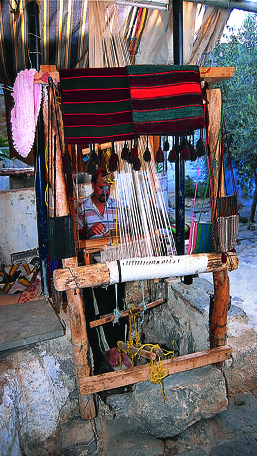
© Prestige / Bassam Lahoud
NAWL ancestral crafts, Oriental loom that survives modernism. The pieces are offered for sale at the workshop.© Prestige / Bassam Lahoud
Access to the inner courtyard of an old house: stone beams at the ceiling, instead of the usual wooden beams. One sits in front of a thousand stalls and colorful items to get some air, and colloquially greeting passersby. The rules of hospitality of Hauran draw on the old tradition.


